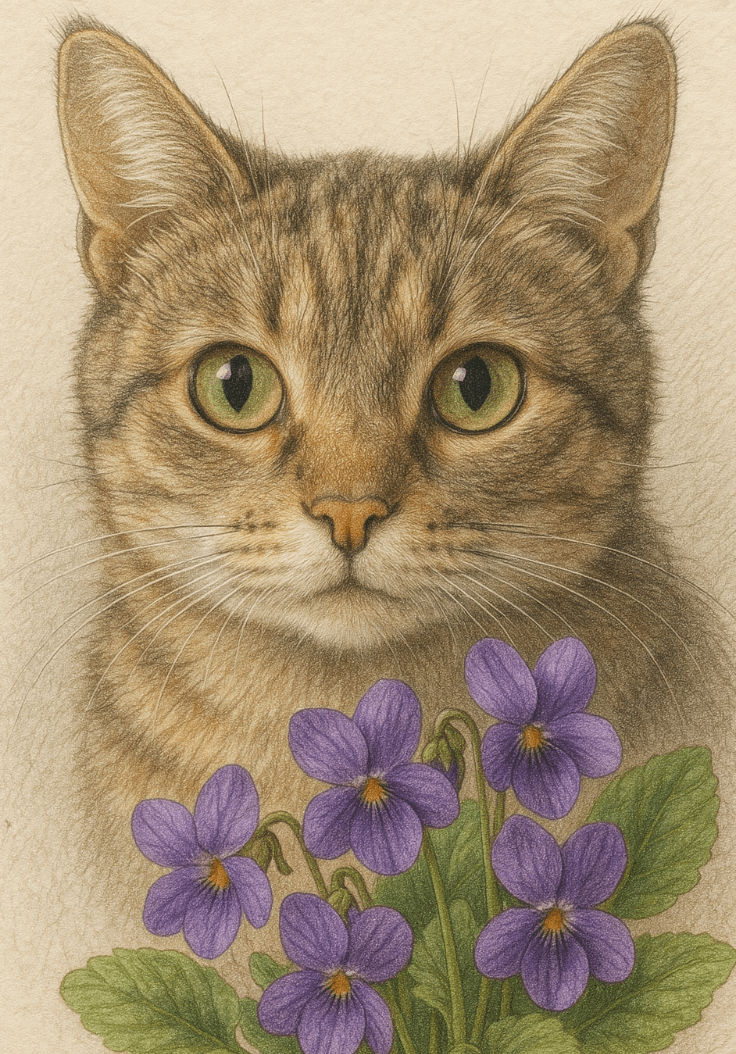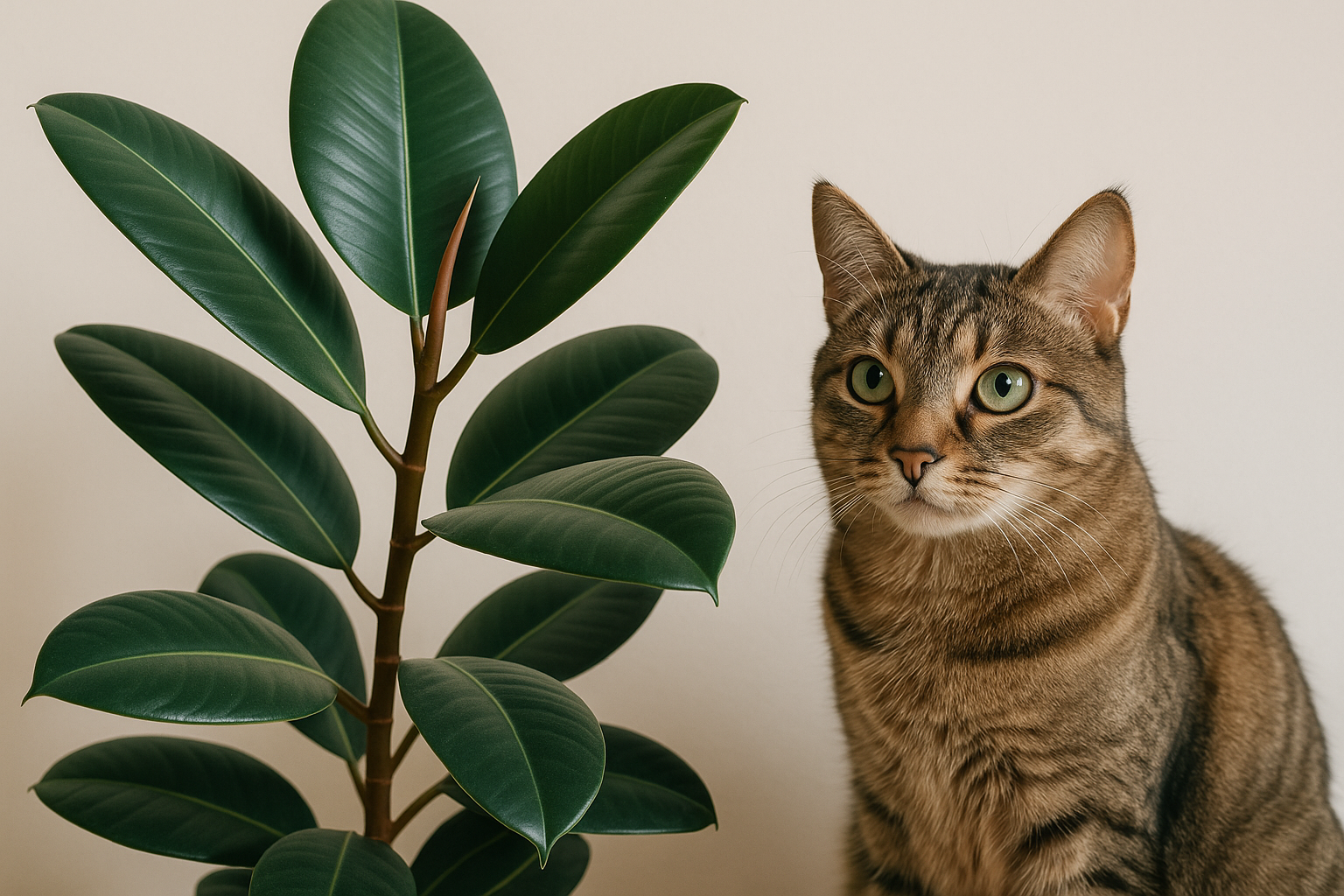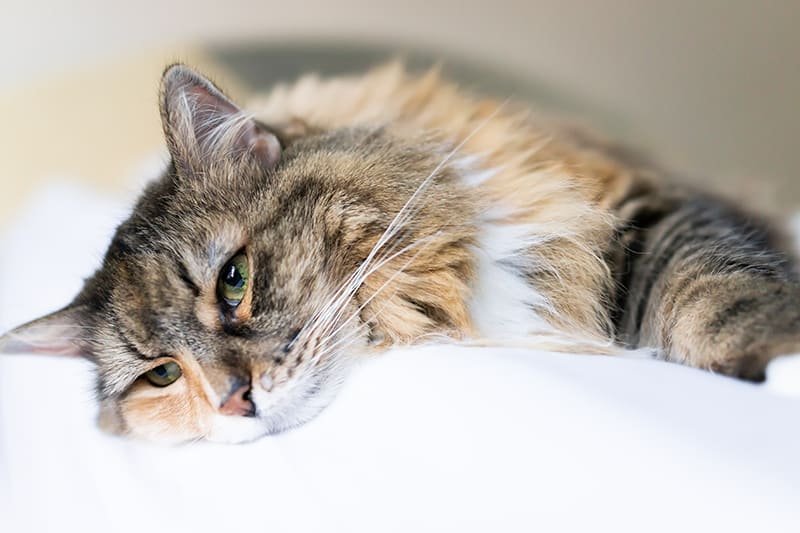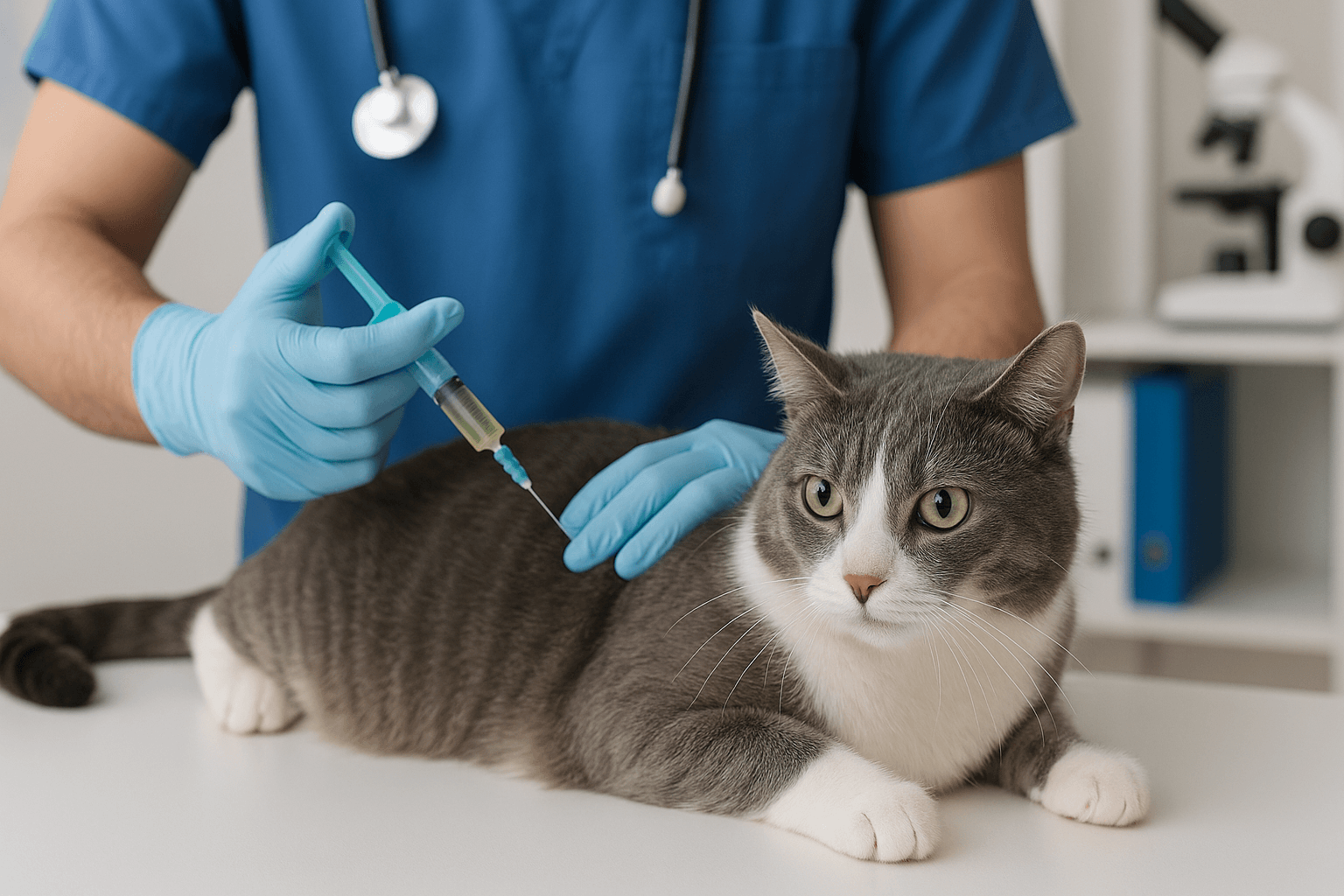Can Cats Eat Violets?
As a cat owner, you’ve probably wondered whether certain plants are safe for your feline friend to nibble on. Violets, with their delicate blooms and lush green leaves, are a common household plant that might catch your curious cat’s attention. But can cats eat violets? The short answer is yes—most violets are non-toxic and generally safe for cats. However, there are important considerations to keep in mind to ensure your cat’s safety and well-being. In this blog post, we’ll explore the details of feeding violets to cats, potential risks, and how to introduce them safely into your pet’s environment.
Are Violets Safe for Cats? Key Points to Know
Before allowing your cat to munch on violets, it’s essential to understand what makes them safe—or potentially risky—for feline consumption. Here’s a breakdown of the key factors to consider.
Non-Toxic Classification:
Most violet species, including African violets, are classified as non-toxic to cats by animal safety organizations. This means they pose no immediate danger if ingested in small amounts.Moderation is Key:
While violets are safe, overconsumption can lead to mild digestive upset, such as vomiting or diarrhea, due to unfamiliar plant fibers.Pesticide-Free Plants:
Always ensure the violets your cat interacts with are free from pesticides, fertilizers, or other chemicals that could be harmful.Variety-Specific Concerns:
Some wild violet species may have slightly different properties, so it’s best to stick to common household varieties like African violets.Allergic Reactions Are Rare but Possible:
Although uncommon, some cats may have sensitivities to certain plants, including violets, which could cause itching or irritation.
By keeping these points in mind, you can confidently allow your cat to explore violets without worry.
Benefits of Allowing Cats to Explore Violets
While violets aren’t a dietary necessity for cats, they can offer some subtle benefits when introduced safely. These advantages make them a worthwhile addition to your home environment.
Mental Stimulation:
Cats are naturally curious creatures, and exploring plants like violets provides mental enrichment and satisfies their instinct to investigate new textures.Natural Grazing Behavior:
Cats sometimes nibble on grass or plants to aid digestion; violets can serve a similar purpose in a controlled setting.Safe Plant Option:
Unlike many toxic houseplants, violets offer a safe alternative for households with pets who love to chew on greenery.Air Quality Improvement:
Violets, like other plants, help purify indoor air, creating a healthier environment for both you and your cat.Bonding Opportunity:
Sharing supervised interactions with your cat around violets can strengthen your bond and encourage trust.
These benefits highlight why violets can be a positive addition to a cat-friendly home.
Check this guide 👉Can Cats Eat Vitamin E Oil? Best 7 Expert Tips!
Check this guide 👉Can Cats Eat Peonies? Best 7 Expert Tips!
Check this guide 👉Can Cats Eat Ricotta Cheese? Best 7 Expert Tips!
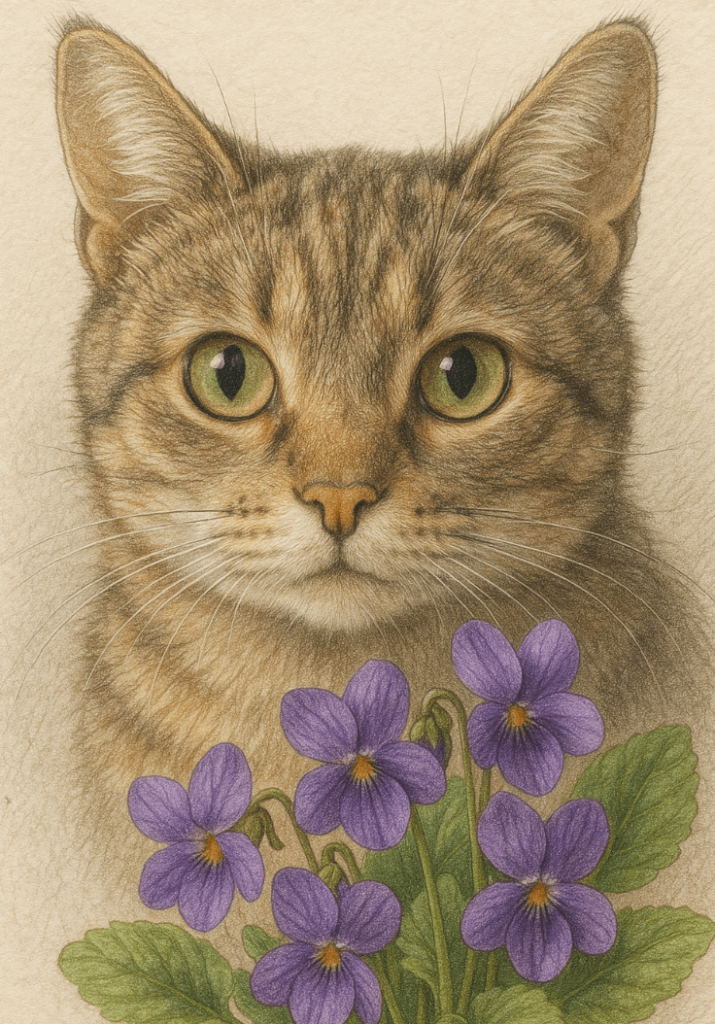
Safe Plants for Cats | Plants Toxic to Cats |
|---|---|
African Violets | Lilies |
Spider Plants | Sago Palm |
Boston Fern | Aloe Vera |
Bamboo | Philodendron |
Catnip | Pothos |
How to Safely Introduce Violets to Your Cat
If you’re considering adding violets to your home or allowing your cat to interact with them, follow these guidelines to ensure a safe and enjoyable experience.
Start with Supervision:
Allow your cat to sniff and nibble under your watchful eye to monitor their reaction and prevent overconsumption.Place Violets Strategically:
Position violets in areas where your cat can safely explore them without knocking them over or making a mess.Check for Chemical Treatments:
If purchasing violets, confirm they haven’t been treated with harmful substances that could harm your cat.Limit Access Initially:
Introduce violets gradually, allowing your cat to adjust to their presence without overindulging.Observe for Reactions:
Watch for signs of discomfort, such as excessive drooling, vomiting, or lethargy, after your cat interacts with the plant.
By taking these precautions, you can create a harmonious environment where cats and violets coexist peacefully.
Signs Your Cat May Have Eaten Too Many Violets
While violets are safe in moderation, excessive consumption can still cause minor issues. Here’s what to look out for if your cat has eaten too much.
Vomiting or Regurgitation:
Overeating any plant material can irritate your cat’s stomach, leading to occasional vomiting.Diarrhea:
Digestive upset may result from consuming large amounts of fibrous plant material.Lethargy or Discomfort:
If your cat seems unusually tired or restless, it could indicate mild gastrointestinal distress.Loss of Appetite:
A temporary refusal to eat might occur if your cat’s stomach feels upset from eating violets.Excessive Drooling:
Chewing on plants can sometimes trigger drooling, especially if the texture irritates their mouth.
If any of these symptoms persist, consult your veterinarian to rule out underlying issues.
Common Mistakes to Avoid When Introducing Violets
Even though violets are safe for cats, there are mistakes to avoid when incorporating them into your home. Being mindful of these pitfalls ensures a smooth introduction.
Using Treated Plants:
Never bring home violets sprayed with pesticides or chemical fertilizers, as these can harm your cat.Leaving Soil Exposed:
Cats may dig in or ingest soil, which can contain harmful bacteria or parasites; cover soil with decorative stones.Overlooking Allergies:
Assume your cat won’t react negatively until proven otherwise; monitor closely during initial exposure.Placing Violets Near Hazardous Plants:
Ensure violets are kept away from toxic plants to avoid accidental ingestion of harmful foliage.Ignoring Behavioral Cues:
If your cat shows disinterest or discomfort, respect their boundaries instead of forcing interaction.
Avoiding these mistakes ensures a stress-free experience for both you and your cat.
Alternatives to Violets for Curious Cats
If you’re looking for other pet-safe plants to complement or replace violets, here are some excellent options to consider.
Spider Plants:
These hardy plants are non-toxic and loved by cats for their dangling leaves, which mimic prey.Cat Grass (Wheatgrass):
Specially grown for cats, wheatgrass aids digestion and satisfies their natural grazing instincts.Boston Ferns:
Non-toxic and visually appealing, Boston ferns add a touch of greenery without posing risks.Bamboo:
Easy to care for and safe for cats, bamboo is an elegant choice for modern homes.Mint (Non-Toxic Varieties):
Certain mint plants, like peppermint, are safe for cats and emit a pleasant aroma.
These alternatives provide variety and enrich your cat’s environment safely.
Fun Ways to Encourage Safe Plant Exploration
Encouraging your cat to interact safely with plants like violets can enhance their quality of life. Try these creative ideas to make plant exploration fun and engaging.
Create a Cat-Friendly Garden:
Dedicate a corner of your home to pet-safe plants, giving your cat a designated space to explore.Use Hanging Planters:
Hang violets at a height that allows your cat to sniff but not chew excessively.Combine with Toys:
Place toys near violets to encourage play and curiosity in a controlled manner.Offer Edible Greens:
Pair violets with cat grass or other edible greens to diversify their plant-based options.Rotate Plants Regularly:
Switch out violets with other safe plants periodically to keep your cat’s interest piqued.
These activities foster a stimulating environment that nurtures your cat’s natural instincts.
Frequently Asked Questions About Cats and Violets
Can all types of violets be fed to cats?
Most common household violets, like African violets, are safe, but avoid wild varieties unless confirmed non-toxic.
What should I do if my cat eats a lot of violets?
Monitor your cat for signs of digestive upset and contact your vet if symptoms worsen or persist.
Are African violets safe for kittens?
Yes, African violets are non-toxic to kittens, but supervision is recommended due to their smaller size.
Can violets replace cat grass?
While violets share some similarities with cat grass, they shouldn’t fully replace it, as cat grass offers specific digestive benefits.
How often can my cat nibble on violets?
Occasional nibbling is fine, but limit access to prevent overconsumption and potential stomach upset.
Creating a Cat-Friendly Home with Violets
Violets are a charming and safe addition to any cat-friendly home, offering beauty, enrichment, and peace of mind for pet owners. By understanding their safety profile, introducing them responsibly, and monitoring your cat’s behavior, you can enjoy the benefits of having violets around while keeping your furry friend happy and healthy. Remember, every cat is unique, so observe their preferences and reactions to ensure a positive experience. With proper care, violets can become a delightful part of your shared space, bringing joy to both you and your feline companion.
Is the Rubber Tree Cat Safe? Best 7 Expert Tips! Discover expert advice on keeping rubber plants safely in cat-friendly homes and learn top tips for pet-safe plant care.
Low Red Blood Cell Count in Cats: Best 7 Expert Tips! Discover causes, symptoms, and treatment options for feline anemia. Learn how to support your cat’s health effectively with expert advice.
Understanding Megacolon Treatment: Best 7 Expert Tips! Discover effective strategies to manage feline megacolon, from dietary changes to surgical options, ensuring your cat’s comfort and long-term health.
How to Register a Therapy Cat: Best 7 Expert Tips! Discover essential steps to certify your cat as a therapy animal, prepare them for training, and make a meaningful impact in therapeutic settings.

